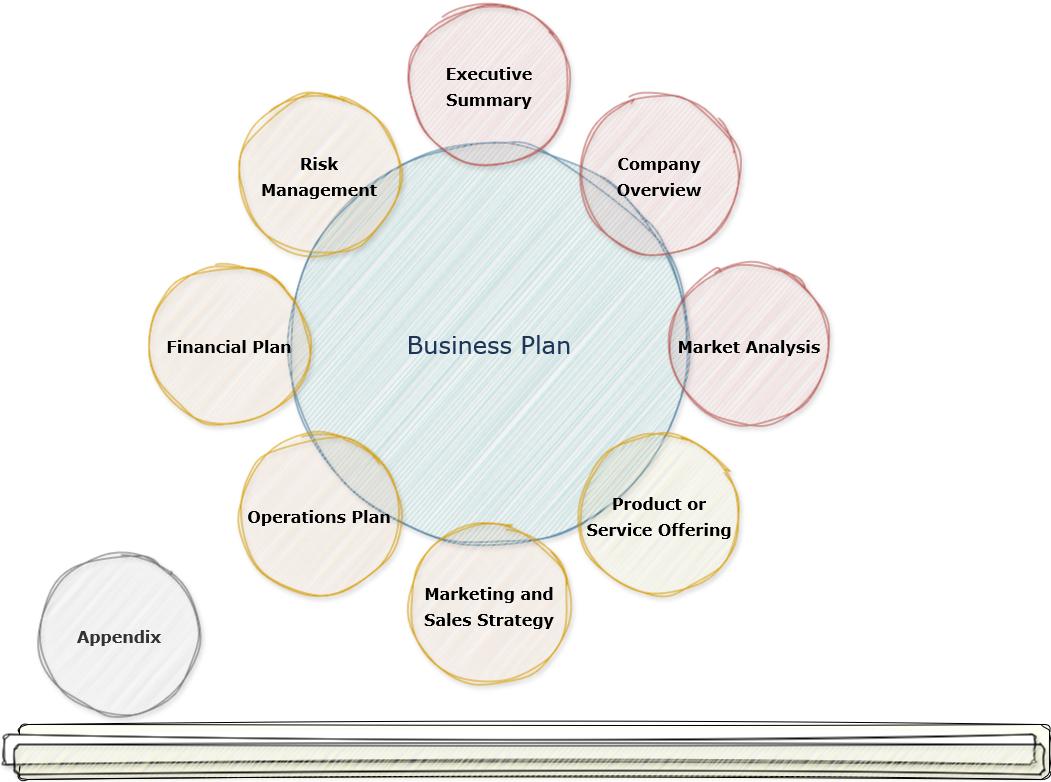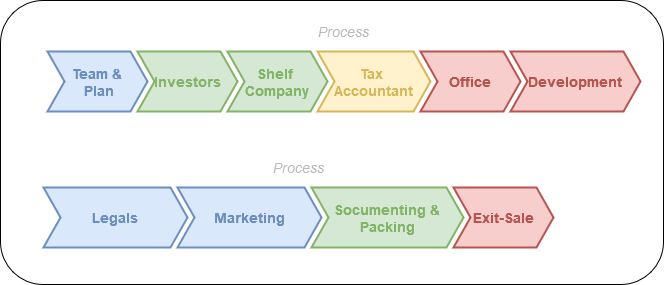Startup Transitioning Beyond the initial Startup Stage
Putting the Building Blocks Together; Where Do We Pragmatically Go From Here?

The shelf company
We have a solid idea and a clear vision. But what’s next? We know that starting a company from scratch is an option—though it can be error-prone and time-intensive—or we could acquire an already established “shelf company.”
A shelf company, often pre-registered and maintained without operations, typically comes with the essentials to get started. For example, if it’s based in Europe, it may already have a minimal startup capital deposited in a bank account and an associated debit card for transactions.
Adapting the Shelf Company to Fit Our Goals
Customizing a shelf company to align with our business goals involves several manageable steps:
- Purpose Adaptation: Adjusting the company’s purpose to cover broader or specific activities.
- Ownership Registration: Including the details of new owners or stakeholders.
- Name Change: Modifying the company’s name to match our brand identity.
These adjustments are handled through a notary, a legal professional responsible for formalizing such changes.
Are We Ready?
Even with a registered entity, the journey has just begun. Establishing the company or purchasing a shelf company is only the first step. From here, the real work of building processes, forming teams, and executing the vision starts.
Starting means expenses. We need a tax accountant and possibly an office with minimal setup. This is exactly why much needs to be clarified beforehand. We need to know and agree on a lot of things. For example, we all need to decide whether to open the company with basic calculations and known risks and metrics.
The next steps would be to create a business plan and prepare it, or to separate a presentation to deliver in front of investors and other stakeholders. It is also possible to create several presentation slides and use them according to the audience and scope.
This is not the case with the business plan. It is supposed to be the blueprint of the company. It is not only for presentation; it is actually for everything. It is used as a checklist before takeoff, for discussions, assessments, negotiations, as a reminder to check certain aspects, and for filling placeholders with information.
Following the outline and enriching it sufficiently with data and information might reveal weak points, mistakes, or areas where more research must be done. It is a working draft that, when reaching a certain stage, allows the company to start. Yet, it also serves as a working draft that will evolve into versions of the base copy as changes occur within the company
The Business Plan
It doesn't take much after starting to think about the necessities to recognize that, with limited resources, there is not much room for mistakes or large investments before many details are clear. The start requires clarity and transparency.
The Lego building blocks contribute to this; we need to minimize risks and uncalculated procedures and processes, tighten up contracts, and address hazards caused by invisible dangers and risks accordingly. To put it all on a sugar spoon and prepare to start, we list the main blocks that we need.
What do we need
A Shelf Company
This refers to a company that can be purchased and made legally operable within approximately two weeks. In Germany, for instance (this is not a recommendation but rather a reference point from which relevant keywords can be derived):
- Limited24: https://www.limited24.de/
- Youco24: https://youco24.de/en/german-shelf-companies/
- VRB: https://www.vrb-gmbh.de/en/shelf-companies/
- Foris: https://www.foris.com/en/shelf-companies/
A Notarial Service
To suit the needs of the local area.
A Tax Accountant
To suit the needs of the local area.
An Office That Is Scalable on Demand
- Fully equipped office with bookable services and spaces.
- Bookable offices to accommodate staff expansions.
- Short contract termination terms.
- International membership with bookable locations.
A Server and Data Platform
- Globally accessible 24/7.
- Scalable servers and capacities.
Computers and Office Devices
- Leased or rented as needed.
Phone and Internet Connection
- Centralized services.
- Individual personal communication and staff accessibility.
- Performance sufficient for teleworking and collaboration.
Workers
- Core staff.
- Additional staff as needed.
Software
- Personal.
- Global services like Google, Yahoo, etc.
- Open-source solutions where applicable and practical.
To make it clearer, we require company registration, associated services, computerization, communication systems, and a functional workspace.
All these elements involve costs. Each must be carefully researched and assessed, and where dependent on schedules or regulations, they should be documented and tracked meticulously. The question of how much these will cost, whether they are affordable, and when profitability might be achieved, is addressed through planning. The answers to these questions find their manifestation in the business plan document.
Remember, we are focusing on flexibility, scalability, and safety.
So, how does the business plan look in outline? Let’s take a look and briefly describe its content and purpose. Additionally, we’ll review where the building blocks fit in.

Business Plan
This is just a suggestion for a structure that would work for a software development project, for example. Some parts can be removed if they are not needed, or additional sections can be added later depending on the project's specific requirements.
- Executive Summary
- Objective: Briefly explain the purpose of the software and platform.
- Vision and Mission: Identify the problem it addresses and the ultimate goal of the platform.
- Market Opportunity: Provide a brief overview of the demand for scalable software solutions in the market.
- Product Snapshot: An outline of key features and functionalities of the platform.
- Key Metrics: Include anticipated timelines, budgets, and growth targets.
- Company Overview
- Background: Share details about your company, its history, and the founding team.
- Business Model: Explain how the platform will generate revenue (e.g., subscriptions, licensing, freemium).
- Unique Selling Proposition (USP): Highlight what makes your platform stand out from competitors.
- Market Analysis
- Industry Landscape: Provide market data related to the software and platform industry.
- Target Market: Define your primary audience (B2B, B2C, or both).
- Competitive Landscape:
- Key competitors in the market.
- Strengths and weaknesses of existing players.
- How your platform surpasses the competition (e.g., scalability, cost-effectiveness, innovative features).
- Product or Service Offering
- Product Overview: Describe the software and the scalable platform:
- Core features.
- Technical framework and architecture.
- Scalability components (e.g., cloud-native, modularity).
- Innovative technologies.
- Development Strategy: Outline your development roadmap:
- Phases: Concept, MVP (Minimum Viable Product), beta testing, full launch.
- Timeline for each phase.
- Future Enhancements: Discuss potential future features and expansion possibilities.
- Marketing and Sales Strategy
- Go-to-Market Strategy: Detail how you plan to introduce the software to the market.
- Launch campaigns, partnerships, and events.
- Pricing Approach: Define your pricing structure (e.g., subscription tiers, one-time fees).
- Customer Acquisition: Identify key marketing channels to attract users (e.g., SEO, social media, email campaigns, partnerships).
- Retention Strategy: Outline plans to retain customers (e.g., support services, loyalty programs, regular updates).
- Operations Plan
- Development Team: Describe the roles and number of team members.
- Technology Stack: Detail the programming languages, tools, and hosting solutions.
- Quality Assurance: Explain the testing and quality control processes.
- Infrastructure: Describe the server setup, cloud providers, and scalability options.
- Financial Plan
- Initial Budget: Outline costs for development, marketing, and legal fees.
- Revenue Forecasts: Estimate potential earnings from subscriptions, licensing, or other income sources.
- Break-even Point: Project when the business will reach profitability.
- Funding Needs: Specify the amount of investment required and its intended use.
- ROI Estimates: Provide a forecast of return on investment for stakeholders.
- Risk Management
- Technical Risks: Consider issues like downtime, bugs, and security vulnerabilities.
- Market Risks: Address challenges like competition or low user adoption.
- Financial Risks: Identify possible cash flow issues or cost overruns.
- Mitigation Strategies: Describe measures to minimize these risks.
- Appendix
- Financial Projections: Include detailed spreadsheets or charts.
- Technical Diagrams: Provide architectural blueprints or system overviews.
- Team Resumes: Attach CVs of key team members.
- Market Research: Share any relevant data or research sources.
This plan should be filled out iteratively. Once the idea is clear and well thought out, the first draft should take about an hour to complete. After that, certain sections will need to be prioritized, such as points 1 and 2, which will be used for the initial presentation. These sections are meant not only for investors but also for team members who will join the project. Throughout the process, it's essential to revisit and refine these parts, as they will evolve over time. It will be helpful to provide a printed version for review, so that specific questions can be raised. These questions can then be used to refine and clarify the plan for better understanding.
While many sections are intuitive, examples of how to fill them with data, tables, and diagrams are easily accessible. It's important to understand the process, but expertise in every section is not necessary. Once the idea is outlined and the presentation slides are prepared, the focus will shift to identifying which sections are critical and which are optional.
As a general rule, the more detailed the plan is—without being cluttered with unnecessary information—the more successful it will be. Use the necessary number of words to convey your ideas, but be very selective with your wording. It should precisely describe the key points. If an answer is not immediately available and requires further research, leave it blank with "TBD" (to be defined) or another suitable abbreviation. This will indicate that the section is still being worked on and hasn't been forgotten, but will be addressed in due course.
The use of versioning for all artifacts is essential for collaborative editing. It may also be necessary to track decisions made, document changes, and number data for various purposes such as backups, as well as presenting changes in the product. This process helps ensure transparency and accountability by capturing the underlying data and information that served as the foundation for decisions made.

Alright, we need a vision, and to describe it, we need notarial services and a shelf company. We also need a tax accountant and a lawyer to review contracts. A list of potential investors should be compiled, or we can announce our project within networks. We’ll need a flexible office that provides all the essentials for a startup.
Regarding the shelf company, we already have a few examples. But what about the list of investors? In every country, there are known venture capital firms that offer various models and terms. As an example, here are some in Germany and Israel:
Major Joint Venture Companies in Israel:
- OurCrowd - A leading global venture investing platform.
- Pitango Venture Capital - One of the largest VCs in Israel- https://www.pitango.com/
- Viola Ventures - Focused on transformative Israeli startups- https://www.viola-group.com/
- Startup Nation Central - Facilitating global connections for Israeli innovation - https://startupnationcentral.org/
- JVP (Jerusalem Venture Partners) - Specializing in technology investments -https://jvpvc.com/
- NFX Guild - Accelerating startups with venture capital backing- https://www.nfx.com/
Major Joint Venture Companies in Germany:
- High-Tech Gründerfonds - Supporting tech-focused startups- https://www.htgf.de/de/
- Rocket Internet - Backing innovative and scalable business models- https://www.rocket-internet.com/
- Project A Ventures - A VC and operational partner- https://www.project-a.com/
- Bavarian Israeli Partnership Accelerator (BIPA) - Facilitating Israeli-German collaboration- https://bip-accelerator.com/
- German Startups Group - Investing in promising young companies- https://www.german-startups.com/fur-aktionare/uber-uns/
- Next47 (Siemens) - Supporting industrial tech startups globally- https://next47.com/
We are looking for a solution for an office, and based on everything I’ve seen so far, my favorite option that meets all the necessary requirements is Regus. However, there are also other similar providers. What really stands out about Regus is its great flexibility, as it operates in many countries where members or clients can book workspaces and meeting rooms with the necessary equipment if required. Their office buildings are centrally located or placed in areas where business operations run more smoothly, such as near airports or in regions with a high concentration of companies. Regus, along with other providers in Germany, for instance, includes others as options like:
- Regus
As one of the leading providers of flexible office spaces, Regus offers a broad array of options, including private offices, co-working spaces, and meeting rooms, with locations in prime business areas and airports worldwide. Their membership system allows access to a global network of workspaces, making it suitable for businesses that require flexibility and scalability - https://www.regus.com/de-de - WeWork
WeWork is renowned for offering dynamic and flexible workspaces that cater to a wide variety of business needs. Their network spans multiple cities worldwide, offering both collaborative co-working environments and private offices. WeWork is particularly appealing to startups and businesses that thrive on community and networking opportunities-
https://www.wework.com/de-DE - Spaces
A part of the Regus family, Spaces delivers creative and modern office environments designed to foster collaboration. The brand targets professionals and teams looking for flexible, stylish workspaces. With locations around the globe, Spaces provides customized office solutions and versatile meeting areas-
https://www.spacesworks.com/ - LiquidSpace
LiquidSpace connects businesses with on-demand office spaces, enabling companies to rent meeting rooms or private offices on a short-term basis. This platform offers flexibility and scalability, allowing businesses to rent spaces as needed in various locations around the world-
https://liquidspace.com/ - Knotel
Knotel provides highly customizable office spaces designed to meet the unique needs of growing companies. Their focus is on scalability, offering tailored solutions that allow businesses to expand or modify their space as necessary. Knotel has a presence in major cities globally-
https://knotel.com/ - Business Center Network (BCN)
BCN offers a range of flexible office solutions, including serviced offices and conference rooms. Their network spans key business hubs worldwide, providing reliable, professional workspaces that can grow with your business-
https://bcnetwork.biz/
Now, it’s time to sit down and start writing. Writing. Writing. Writing. The cycle of writing, researching, and communicating will never truly end.
Good luck.
Glossar
| Term/Concept | Description |
|---|---|
| Shelf Company | A pre-registered, non-operational company that can be purchased to save time in company setup. Includes basic legal setup. |
| Notarial Services | Legal services provided by a notary, essential for formalizing documents like ownership changes and company registration. |
| Tax Accountant | A professional to manage company taxation, financial records, and compliance with local tax laws. |
| Flexible Office | Workspace solutions, often with short-term contracts, equipped with essentials for a startup (e.g., desks, meeting rooms). |
| Server/Data Platform | A globally accessible IT infrastructure enabling data storage, sharing, and scalability. |
| Business Plan | A detailed document outlining the vision, strategy, and financial plan for the startup. Serves as a blueprint for growth. |
| Trademarking | The legal process of securing the rights to a brand name, logo, or symbol for business protection. |
| Venture Capital Firms | Companies that provide funding to startups in exchange for equity or returns on investment. |
| Risk Management | Identifying, assessing, and addressing potential risks (technical, financial, market) to ensure business continuity. |
| Versioning | Tracking changes and iterations of documents, code, or plans to maintain organization and accountability. |
| Market Analysis | Researching the industry landscape, target audience, and competitors to define the startup's market position. |
| MVP (Minimum Viable Product) | An initial version of a product with just enough features to gather feedback and validate the concept. |
| Go-to-Market Strategy | A structured plan for introducing a product to the market, targeting customers, and gaining competitive advantage. |
| Lego Building Blocks | A metaphor for modular, scalable components needed for business operations, ensuring flexibility and efficiency. |

